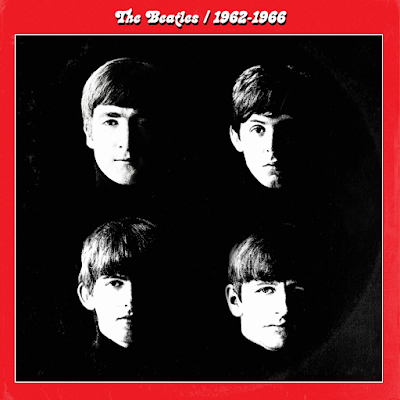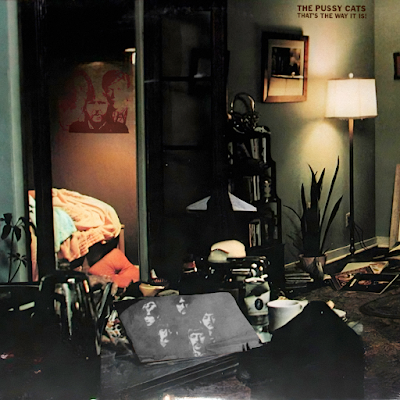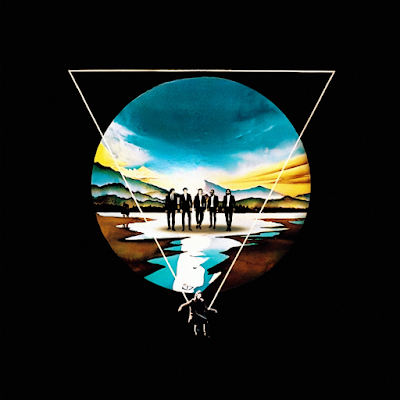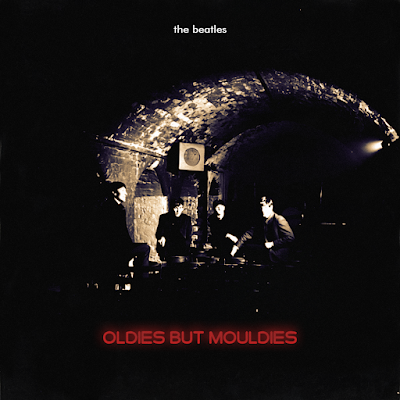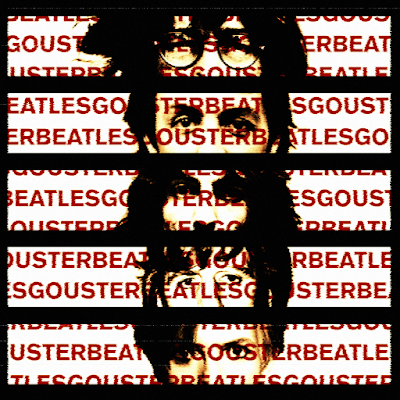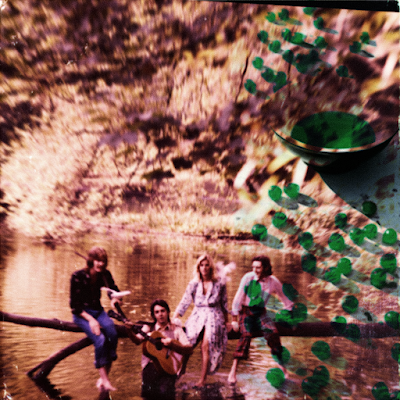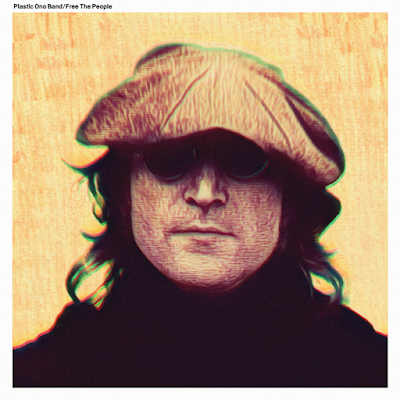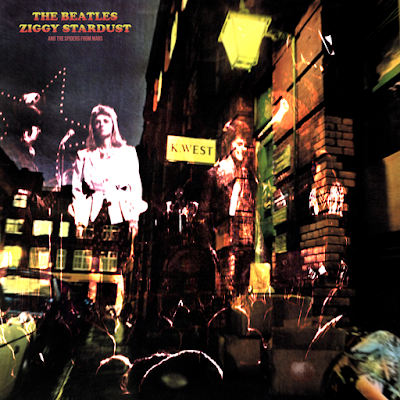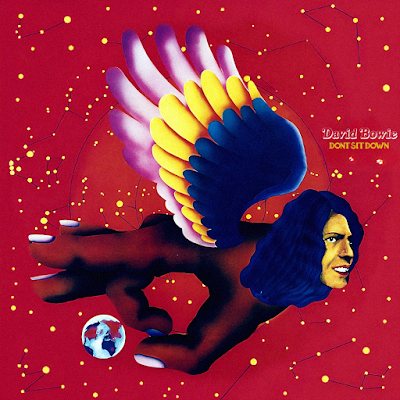Intermission: Beatles Live (1974)
Intermission: The Red/Blue/Green Albums (1973-1975)
The Pussy Cats - That's the Way It Is! (1976)
David Bowie had left the Beatles so he could find himself and, hopefully, quit his crippling drug habit that had been a part of him for the best part of 3 years. But this all didn't happen immediately. He was quite lazy, and took up temporary residence in Los Angeles, alongside the other former Beatle John Lennon. Kicked from his own band, Lennon was also starting to recover from his own drug and alcohol problems, although he was quite lazy as well. In the middle of it all was Harry Nilsson, a close friend of both Lennon and Bowie, a chart-topper in his own right. He never had a crippling drug addiction and his heavy drinking had subsided due to a ruptured vocal cord in 1974. During these times, the three hanged out often, usually ending the night at one of their favorite bars or restaurants. One night, Nilsson mentioned that the three of them should record an album together, although it was not a serious offer. The next morning, Bowie called the other two saying he had booked studio time for them, and right then, recording sessions began for their first album together.
For three junkies plunking away on any instrument they could get their hands on, recording sessions went surprisingly smooth, with them finding each other's vibes pretty quickly. In stark contrast to Station to Station, both Lennon and Bowie's most recently released material, the album had a soft rock/reggae feel to it, no doubt due to them not caring enough to attempt anything musically new. The album included four covers, including "That Is All", an unused song written by George Harrison that was given to Nilsson to sing. The band and album names were the last things given to the record. They called themselves the Pussy Cats, named after Nilsson's 1974 album of the same name (which Lennon produced). The album's name, That's the Way It Is!, came from Walter Cronkite's famous catchphrase, with Cronkite being a familiar face to all three of them.
The album released on July 9, 1976 to generally positive reviews. Critics appreciated the laid-back sound, and they hoped for another record from the three. Unfortunately, it was not to be, and this would be the only Pussy Cats album.
Soon after the album's release, Lennon finally reunited with Yoko Ono. She announced her pregnancy two months later, and Lennon decided to take an indefinite hiatus from music to focus on his family.
This left David Bowie alone. He still wasn't ready to rejoin his old band, and LA was already starting to look old to him. He started to retreat back into his worst habits until one night, he got a call. It was from his old friend Iggy Pop, and he said he wanted Bowie to meet up with him and Brian Eno. He agreed. Bowie was going to Berlin.
Bowie's songs are from Station to Station, with the exception of "I'm Only Dancing (Again!)" from Who Can I Be Now (1974-1976). Lennon's songs are from Walls and Bridges, with the exception of "Do You Want to Dance" from Rock 'n' Roll and "Since My Baby Left Me" from Menlove Ave.. Nilsson's songs are from ...That's the Way It Is. "So Long Ago" is "#9 Dream" from Walls and Bridges.
 |
| Back cover |
The Beatles - Station to Station (1976)
Following the back-to-back successes of Gouster and Oldies but Mouldies, the Beatles' next record would be made under tense conditions. Infighting had flared up again, similar to the Get Back sessions of 1969, no doubt due to the personal lives of most of the band's members being in shambles. John Lennon and George Harrison were fighting double heroin addictions, David Bowie basically depended on cocaine, and Ringo Starr was a functioning alcoholic. Only Paul McCartney stayed clean throughout the turbulent 70's, thanks to the help of his loyal wife, Linda. The band had initially decided to take a break from recording to pursue other ventures. Starr and Bowie pursued their film careers, starring in "Lisztomania" and "The Man Who Fell from Earth" respectively. McCartney spent time with his family, and Harrison spent more time out with his new friends from Monty Python. But it was Lennon's antics that made headlines. Still apart from his estranged wife Yoko Ono, he would regularly drink and party with his other musician friends, his favorites to hang with being Bowie and his close friend Harry Nilsson. These antics would not be a good look for the band, and Lennon's behavior would only get worse as time went on.
Thankfully, by the time the band reunited in December 1975 to record their next album, Harrison had kicked his drug habit, and Starr and Bowie were functional enough to record their bits well. Lennon, on the other hand, rarely showed up to recording sessions, and he contributed a single song throughout the three months of recording (and even that was mostly written by Nilsson). The band soldiered on without him, and by the sessions' end, they knew that they had made yet enough masterpiece.
The resulting album, Station to Station was released on April 1, 1976. Immediately, fans and critics alike lauded it as one of their best albums ever, if not their best. They specifically pointed out "Return of the Thin White Duke", Side B's only song, as the album's clear focus. The song follows a man that goes by The Thin White Duke as he goes on a journey to find fulfillment, with Jewish mysticism being used as a metaphor throughout. The Beatles celebrated yet another success, but this didn't end the band's tensions.
It all came to a boiling point on April 17, 1976, when Lennon sat down for an interview as promotion for the new album. Clearly drunk, he spent the interview destroying the band he had founded, calling it "a shell of its former self". He cited McCartney and Harrison as being extremely difficult to work with and saying that Bowie had "fucked over their sound". For the band, this was the final straw. And so, on April 26, not even a month after their latest album had released, it was announced to the public that Lennon had been kicked from his own band until he could kick his addiction. Lennon took it in stride, with him feeling a newly found sense of freedom. David Bowie, too, was at a crossroads, not only in his career but in his life. His cocaine addiction had overtaken him, leaving him a changed man. And now John Lennon, someone he looked up to, was at an extreme low point in his own life and had been kicked from the Beatles. Something had to change, and Bowie knew he had to be the one to initiate. And so, in May of 1976, Bowie announced that he would take an indefinite hiatus from the group to find himself, but everyone knew that he would be back eventually.
Now, with just Paul McCartney, George Harrison and Ringo Starr, what is a band to do?
I've made a full mix for this album that you can listen to here:
 |
| Back cover |
The Beatles - Oldies but Mouldies (1975)
In 1969, John Lennon wrote the song "Come Together", and it was recorded with the Beatles for their landmark album, Space Oddity. It bore a resemblance to an old Chuck Berry number called "You Can't Catch Me", and this didn't go unnoticed. In 1973, the song's original publisher, Morris Levy, sued Lennon for infringement, and the case was brought to a New York court. While the ordeal was settled out of court, Levy announced that Lennon had to record three songs by Big Seven publishers for his next album, whether it be a band or a solo record. Work began in late 1973, but was paused when the Beatles started the framework for the now-unfinished Nineteen Eighty-Four film.
By the time work for Lennon's covers began, he had fallen into a rough spot. His wife, Yoko Ono, had caught Lennon making out with another girl while at a party celebrating President Richard Nixon's resignation which had led to a temporary hiatus in their relationship. He began drinking regularly with friends like Harry Nilsson as well as his bandmates David Bowie and Ringo Starr. His "Lost Weekend", as it would later be called, continued into 1975, and he barely contributed to Gouster, the Beatles' 1975 album. He managed to sober up just enough to record his quota for three covers, along with the other Beatles recording their own, in late 1975, and the result, Oldies but Mouldies, was issued as a double EP. Reception was positive, but people realized after Gouster that this was simply a stopgap album meant to kill time for their next big album.
Wedding Bells (Are Breaking Up That Old Gang of Mine)
Tracks are sourced from CHOBA B CCCP, Rock 'n' Roll (2004 reissue), Five Years (1969-1973), and All Things Must Pass (Super Deluxe edition).
 |
| Back cover |
The Beatles - Gouster (1975)
The Beatles' world tour had come to an end, and Future Legends had released to positive reviews. Yet, the band was not happy with their overall sound. They had done the same style for years, with their current phase starting somewhere in 1971. And, as always, they quickly got bored of doing the same stuff for too long. John Lennon and David Bowie had come to love funk and Philadelphia soul, no doubt due to their close affiliation with the United States. They both knew that this was the next evolution in their sound. And it wasn't a complete jump either, with "Goodnight Vienna" and "Rock 'n' Roll with Me" from Future Legends and "1984", a non-album single, inhibiting elements of the two genres. Work began on a new Beatles album that would bring a breath of fresh air for the band, with the tight sound of the tracks contrasting with the laid-back energy of the recordings and the sessions that birthed them.
It was also around this time that George Harrison was officially brought back into the band, after a disappointing start to his solo career. By now, Harrison and Bowie had made amends, and the overall mood in the studio was actually the best it had been in years. Luckily, Harrison was also interested in soul, coming up with a few compositions of his own. It all culminated into what would become a cohesive album, one that didn't take itself too seriously, at least not to the same amount that Future Legends did. The album, Gouster, released on May 16, 1975 to generally favorable reception. It came as a complete surprise to fans who expected the same style they had always done, with one critic calling it "the greatest left turn in Beatles history". The Beatles would soon announce another smaller tour that would start in August 1975, their first tour in almost 10 years with Harrison.
Tracks are sourced from Ringo's Rotogravure, Walls and Bridges, Young Americans, Venus and Mars, Thirty Three & 1/3, and Extra Texture (Read All About It). "It Ain't Over" is "Win" from Young Americans.
 |
| Back cover |
The Beatles - Future Legend - Music from the Curiosity Shoppe/Shoot Us Instead (1974)
The Beatles were on top of the world. Their last two studio albums, both titled Ziggy Stardust, were massive successes, and the world tour that followed was immensely well received. But now, starting in 1974, the Beatles were at a crossroads. David Bowie was willing to retire the Ziggy Stardust character in favor of something new, and their glam rock inspired sound was starting to get tired and old to the Beatles, as was usual of them. A new opportunity would come when George Orwell's estate allowed the Beatles to do a film adaptation of Nineteen Eighty-Four, one of Bowie's favorite novels. Before filming started, the Beatles would take the opportunity to write new songs for the film and its inevitable soundtrack album. However, before filming could begin, legal issues made it impossible for the film to be created, and it was scrapped. It was a massive blow to the band, but they now had a large amount of songs that could be put towards an album with its own identity.
Over a longer period of time, the album became Future Legend - Music from the Curiosity Shoppe, a nickname coined by John Lennon for the studio the band recorded in, and it was released on May 24, 1974. Compared to their previous works, this album was quite experimental and varied in terms of genre, harkening back to the White Album sessions of 1968. Whether you wanted the hard rockers, the ballads or even a country tune, the Beatles had you covered. The album was received very well, with critics pointing out this variability as a plus, although it wasn't received as well as the Ziggy Stardust albums. Retroactively, it would also be praised for its astounding production job, being done entirely by the band themselves. It was a good time to be a Beatles fan, with so much material being released.
 |
| Inner gatefold |
George Harrison - It Is He! (1974)
Following the success of The Concert of Bangla Desh and it's accompanying studio album, George Harrison decided to rest and take a semi-hiatus from recording, something normally off for him. People were used to new music from him all the time because of the Beatles, but now that he was out, he could record whenever he wanted. During this time off, he would produce and record here and there for other artists such as Badfinger, Lon & Derrek Van Eaton and Harry Nilsson. This streak would end after he went on a tour of North American with close friend Ravi Shankar from February to March of 1974. Fresh off his streak as a Beatle, the tour would be received fairly positively, but would pale in comparison to the Beatles' Spiders from Mars tour, which would happen at the same time. Afterwards, Harrison would hit the studio to make his second studio album, using songs he had written over his hiatus.
The resulting album was It Is He!, and it released on June 3, 1974. The album was filled with religious undertones, as well as songs about loving one another and, of course, Harrison himself. Contrary to Harrison's first album, critics didn't take to it, and it was a commercial failure. Almost overnight, it seemed that Harrison's solo career had fallen flat. It seemed that, since the Bangla Desh concert, people hadn't taken an interest to him anymore, especially with his old band still topping charts and making masterpieces. After some deep thinking on where he would take his career, he decided to go to his phone and make a call to an old friend of his.
All tracks are from Living in the Material World and Dark Horse, with the exception of "You" and "You (Reprise)" (A Bit More of You) from Extra Texture (Read All About It).
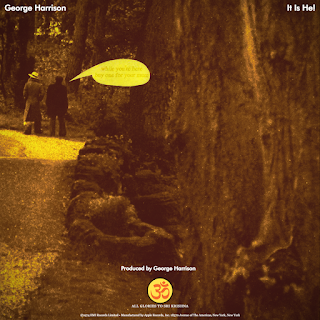 |
| Back cover |
David Bowie - Panic in Detroit (1973)
David Bowie's second solo album, Panic in Detroit released on October 19, 1973. It was the summation of a few ideas Bowie had floating around, both for the Beatles and for himself. He had a few songs from the Ziggy Stardust duology that had gone unused, a testament to his songwriting ability. Three of the songs, including the title track, were included on Side A, with "Time" and "Lady Grinning Soul" being written for the solo album. These five tracks, put together, made a mini rock opera that sets one final curtain for the Ziggy Stardust character. The B-side, on the contrary, was all covers, a remnant of another idea that Bowie had of making a British rock covers album that would encapsulate the songs of his youth. In the end, the only song not from a British band was "White Light/White Heat", a favorite for Bowie to perform live, by American group The Velvet Underground. Other covers were from The Who, The Rolling Stones, Pink Floyd, The Yardbirds and even his own band, The Beatles, with John Lennon himself lending a guitar part to "Across the Universe".
The album was received well, but was mostly seen as Beatles scraps, similar to Paul McCartney's solo debut. Most of the attention went to the album's hellish front cover, featuring Bowie holding a dog on it's hind legs surrounded by fire. A comparison to Satan Is Real by The Louvin Brothers, an album with one of the most infamous covers, was obvious, but the cover would end up being one of Bowie's best. This album also marked the end of Bowie's portrayal of Ziggy Stardust, although a picture of Bowie with supermodel Twiggy on the back cover had him wearing something similar to the Stardust outfit.
All songs on Side A are from Aladdin Sane. Songs on Side B are sourced from Pin Ups, Aladdin Sane, Bowie at the Beeb, and Young Americans.
 |
| Back cover |
Paul McCartney - McCartney (1974)
Paul McCartney's debut solo outing, aptly named McCartney, was released on January 28, 1974. With the exception of "Big Barn Bed" (an outtake dating back to the Hunky Dory sessions), the album took a laid-back easy-listening approach that ended up being popular to long-time fans. The album also notably featured Paul's wife, Linda, on various instruments and backing vocals, a first for her on a studio recording. She would continue to record with Paul, and eventually the Beatles, throughout their long careers. Reception towards the album was generally positive, although less so than either John Lennon or David Bowie's solo outings, released around the same time. It's most notable feature was the four-song medley at the album's end, hearkening back to McCartney's medley-making skills on Space Oddity five years prior. It was criticized for it's relative boringness and inferiority to the Space Oddity medley.
All songs are sourced from Wild Life (Archive Collection) and Red Rose Speedway, with the exception of "Mamunia" from Band on the Run, "Hey Diddle" from Venus and Mars (Archive Collection), and "Mama's Little Girl" from The 7" Singles.
 |
| Back cover |
Plastic Ono Band - Free the People (1973)
Following the massive successes of the Ziggy Stardust duology, the Beatles finally decided to give into demand and go on a world tour, their first since 1966. The tour went from July of 1973 to March of 1974, starting in Europe before going to North America, then Japan and then back to North America. They mostly played their hits from the 70's, although a select few 60's songs were added as the tour on to keep things interesting. As expected, every concert played was sold out, and the reception was incredibly positive. After all these years, John Lennon, Paul McCartney and Ringo Starr were just as in sync as ever, and David Bowie's stage presence was almost trance-inducing.
During the tour's off-time, Lennon, McCartney and Bowie all took up solo projects to keep themselves busy. Fly had been a commercial failure, but Lennon didn't want to stop working with Yoko Ono. The two worked on a new, more commercial-friendly studio album along with the Plastic Ono Band. As with Fly, Starr appeared on a few tracks alongside close friend Harry Nilsson. The album, Free the People, was released on October 29, 1973, to much better reception from critics. However, the constant, dark political banter turned many people off from listening the entire way through, and some were confused how this could be the same Lennon as the jovial one they heard on Beatles records and on stage. In reality, Lennon's marriage and mental health was going down fast, something that would only get worse as the year went on.
The back cover, completely blank white, was done as a nod to Lennon and Ono's conceptual country, Nutopia. It was established as a satirical way to deal with Lennon's immigration problems. The country's anthem appears as the album's hidden track.
All songs are sourced from Approximately Infinite Universe, Mind Games, and Some Time in New York City.
 |
| Back cover |
The Beatles - Ziggy Stardust and His Band on the Run (1973)
Ziggy Stardust and His Band on the Run was the sequel to Ziggy Stardust and the Spiders from Mars, and released exactly three months after the latter on July 20, 1973. Recording for the album went about two months after the conclusion of the Spiders from Mars sessions to make way for new song ideas from John Lennon and Paul McCartney that would fit with the concept of the album. David Bowie had written his songs in a very short span of time, fitting with the idea that Bowie's songwriting and and stage presentation was growing at a rapid rate to the point of Lennon and McCartney having a hard time keeping up. Unlike Spiders from Mars, whose two paragraph story was featured prominently on its inner gatefold, there was no such story anywhere on Band on the Run. In fact, it was almost as if the Beatles had given up on the concept somewhere through the recording of the album, a fact McCartney would later confirm simply because they were getting bored of the whole thing. Even to the normal listener, it was clear that there was a story in there, such as the title track being about the band's escape, Walls and Bridges being the escape theme, Out the Blue summing up Ziggy's life on Earth, and Rock 'n' Roll Suicide being about Ziggy's second and final death. In later years, fan would connect the dots by creating their own story in order to keep the album interesting.
The album was received positively by critics and fans, as per usual. However, critics still had the same glaring problem with it that they had had from the previous album: Bowie had too many songs. It was easy to avoid with the previous album since it was a double LP, but now, Bowie had almost half of the songs on a single LP and was now the clear centerpoint of the group, as seen on the front cover, alienating old fans. In retrospect, this would be the last occurrence of this, with Lennon and McCartney asking for their job as leader back after the album's release. In later rereleases, both Ziggy albums would be released as one triple album titled The Rise and Fall of Ziggy Stardust and the Spiders from Mars. This further connected the second album to the first to make a more cohesive story.
Bowie's songs are sourced from Ziggy Stardust and Aladdin Sane. The rest are sourced from Band on the Run, Mind Games, Walls and Bridges, and Ringo. "Walls and Bridges" is "Beef Jerky" from Walls and Bridges.
 |
| Back cover |
The Beatles - Ziggy Stardust and the Spiders from Mars (1973)
David Bowie had always yearned for fame and success. In his search for success, he had tried out a variety of alter egos and guises as influence for his studio recordings and live performances. These attempts got him varying amount of success, and by the time he had joined the Beatles, he basically dropped the idea entirely. That was until late 1971. Bowie played local clubs and venues with his side band Hype when the Beatles weren't recording or playing the odd performance (John Lennon hadn't gotten fully around to playing live just yet), and it was during this period of time that he began to develop a character, one that would serve as the main character of a story that would play out on an album. The androgynous space alien was inspired mainly by Vince Taylor, but Andy Warhol, Lou Reed, Iggy Pop and Gary Glitter would all serve as other influences.
After farming out songs within a matter of months by the summer of 1972, Bowie knew he had a goldmine on his hands and knew he had to save it for the Beatles. Lennon and Paul McCartney surprisingly liked what they heard, although McCartney famously told Bowie to "tone down the poof stuff". Recording began in late 1972 with Lennon and McCartney giving Bowie full reign of the project. This proved to be an issue down the line, as Bowie couldn't stop writing new (and really good) songs. With the amount of songs that Bowie (as well as Lennon and McCartney) had, the band decided not only to make the album a double, but to extend the story into a second album that would release sometime after the first. Bowie's vision of the story grew more and more to the point of hyper-fixation. In later years, Bowie would release entire manuscripts of unused Ziggy Stardust concepts.
The album, Ziggy Stardust and the Spiders from Mars, would release on April 20, 1973. It's release would prove massive, with rock critics and fans alike agreeing that the Beatles had finally caught up with other huge bands at the time. A rock opera was just what they needed to reach out to old and new fans and bridge the gap between classic rock and the emerging glam-rock subgenre. The only thing people criticized was just how much Bowie contributed. It was starting to feel like Lennon and McCartney were being left out, even though it was still their band. Their next album, released only a few months later, would prove the criticism even more correct.
Story for Ziggy Stardust and the Spiders from Mars:
A news broadcast reveals that Earth only has five years before impending apocalyptic disaster. People around the world hear the news as they go about their everyday lives. They show a mix of negative emotions, with some feeling confused, some going about their everyday lives and some turning to God to be saved. A rock star space alien named Ziggy Stardust and his backing band, The Spiders from Mars, introduces themselves, and Ziggy proclaims himself a savior for the human race. He shines his message of hope over the people, saying only they can save the world. He tells them through radio to relieve their sins while still having a good time. The people revere him as a god-like figure.
Ziggy and his band go on a world tour, bringing goodwill to all in his path. He plays the hardest rock and roll music of his day, with his atonement of sin ironically bringing more sin through his raunchy music. It's because of this that Ziggy questions his role as a rock and roll star and asks if it's all worthwhile. Sure it may be easy for him to say it, but if all he gets is sex and appraisal, what's the point of it all? Ziggy is put in front of the stage and abandons his sexual climax for a chance at stardom, and yet he fails, leading to his downfall. His downfall makes him down and out, leading to a figurative "Meat City", before realizing he can't satisfy his fans. He dies, not in blood, but directly on the stage as the whole world watches. But it is for naught, as the wishes of the audience brings him back to life as a new, and holier, man. His band is not so lucky, and they are arrested. Now they have to watch the world burn stuck inside those four walls.
Tracks are sourced from Ziggy Stardust, Red Rose Speedway (Archive Collection), Mind Games, Imagine (Ultimate Collection), Ringo, Aladdin Sane, Venus and Mars (Archive Collection), Menlove Ave., Five Years (1969-1973), and Goodnight Vienna. "Good Morning, Young Master" is "1882" from the Archive Collection of Red Rose Speedway. A mix is planned for this album in the future that fixes transitions.
 |
| Back cover |
The Beatles - Run for the Roses (1972)
The sessions for the Beatles' next album would be instantaneous, unlike others in the past. No one had any prior plans, Hunky Dory and John Lennon and David Bowie's solo albums had been successful, and they each had enough leftover songs from past sessions to use on another album. So, as usual, the Beatles decided to soldier on and create another masterpiece. Due to most of the songs already being written beforehand, recording would go much faster than Hunky Dory did, and the album was finished in the span of about two months. Compared to Hunky Dory, the sound of the album was more all over the place, with a mix of glam and blues rock and even some vaudeville. But overall, they were louder than they had been before, something they knew fans would be interested in.
The resulting album, The Red Rose Speedway, was released on May 12, 1972. It was clear from release that fans didn't immediately take to it as much as they had with their previous three albums. It scored generally positive, but the lack of new songs was apparent, with some critics even going as far as saying that more than half of the album was filler. Those same critics would point out some high points, such as Paul McCartney's "Uncle Albert" medley or Bowie's "Quicksand". And because the Beatles barely wrote any new material, its relative failure really didn't come as a blow for them. It meant that they had to keep looking for a new sound that would wow their fans. And that sound would come much sooner than they had any reason to think.
Due to how the album's back cover looked, few people realized that, unlike the other three Beatles whose pictures were taken for the album, Bowie's picture was taken from the Hunky Dory sessions the year before. This was due to Bowie undergoing a complete makeover in appearance following the end of recording. The reason for this makeover was to serve as inspiration for Bowie's next project, one that would transform the band forever.
George Harrison - Long Play for Bangla Desh (1971)
Committed to continuing his music career following his departure from the Beatles, George Harrison started working on his debut solo album almost immediately after. He decided to bring in Phil Specter as co-producer, and the album contained a rotating cast of well-known characters, such as former band members John Lennon and Ringo Starr, Eric Clapton and the rest of Derek and the Dominos, Billy Preston, Klaus Voormann, Pete Drake and Badfinger. Despite his newfound freedom, most of the songs recorded were not new, with most being written during his time in the Beatles with a few even being rejected outright by Lennon and Paul McCartney. But since he was on his own, no one could tell him what or what not to do.
Leading up to the release of the album, Harrison would put together the Concert for Bangla Desh, a relief concert (the first of its kind) that would donate all money to the ailing people of Bangladesh following the Bangladesh Liberation War that was still ongoing. Performers would include himself, Ringo Starr, Bob Dylan, Billy Preston, Ravi Shankar and Leon Russell. Two concerts were performed and it was seen as a total success. People had wondered if the Beatles would be invited to the concert, and some even wished for a reunion between George and the band. However, it was found out later that George had gone out of his way to not invite the band.
George's first studio album, Long Play for Bangla Desh, was released on December 20, 1971. Also released on this day was the live album for The Concert for Bangla Desh. Harrison would joke that "To promote the album, we're also releasing the coffee mug for Bangla Desh and the refrigerator for Bangla Desh". Both albums would be received generally positive, although critics pointed out that it made for somewhat of a dour listening experience due to the pointed nature of the songs. "Without John's wit and Paul's whimsy, George's album does not feel as intelligent as it should be" one critic said.
All tracks are from All Things Must Pass and Living in the Material World, with "Bangla Desh" and "Deep Blue" being bonus tracks from the latter's 2014 reissue.
David Bowie - Don't Sit Down (1972)
In addition to John Lennon and Yoko Ono's output, David Bowie also had a large amount of songs that had gone unused from the Beatles last two albums. Bowie booked recording sessions following the release of Hunky Dory to record songs that had originally been recorded by the Beatles, along with a few new songs. The resulting album was Bowie's first solo album, Don't Sit Down, released March 3, 1972. The style of Side A matched The Man Who Sold the World, and Side B matched Hunky Dory. The result is a mesh of both sounds that only sounded natural for Bowie. The final song, "I'm Only Dancing" was written after fellow band member John Lennon disapproved of his choice of clothing for his live performances.
Songs are sourced from Space Oddity, The Man Who Sold the World, and Hunky Dory. "Holy Holy" and "I'm Only Dancing" are sourced from Five Years (1969-1973), and "It Ain't Easy" is from Ziggy Stardust.
Plastic Ono Band - Fly (1971)
Following the release of The Man Who Sold the World and George Harrison's departure, John Lennon decided to take some time off from recording to spend time with his wife, Yoko Ono. During this time, he would hone his primal therapy that he and Ono had learned through Arthur Janov's classes in Los Angeles for most of the previous year. They never finished their classes due to their expiring visas, but they were taught to scream their way to enlightenment and to release emotional pain from their respective childhoods. They had also visited New York City during this time, and they would move to the city in August. But, despite his time off, he knew he needed an outlet for the therapy he was going through. Feeling that his newest material was far too personal for use in the Beatles, Lennon and Ono decided to record an album with just them and the Plastic Ono Band, made up of Klaus Voormann, Alan White and Billy Preston. Beatle Ringo Starr and former Beatle George Harrison also made appearances during the recording.
The resulting album was Fly, credited solely to the Plastic Ono Band. The album was half rock, half experimental, and all extremely personal and sometimes uncomfortable. The album was built around Lennon's songs with Ono's experimental pieces being placed in between them. It was released on September 21, 1971 to generally positive reviews. Critics would say that Lennon's songs were some of his best ever, even with the Beatles. Ono's songs weren't as lucky, with critics mostly calling them "drab". She would get redemption retrospectively, with some even saying that her songs predated the creation of krautrock.
Isolation
Lennon's songs are sourced from John Lennon/Plastic Ono Band and Imagine, with "Do the Oz" taken from the Ultimate Collection and "How?" being Take 40. Yoko Ono's songs are from Fly, and "Who Has Seen the Wind?" and "Listen, the Snow Is Falling" are from the CD reissue of Wedding Album. "Fly (Prologue)" is "Head Play (Medley: You/Airmale/Fly)", and "Fly (Part 2)" is "You".
-
David Bowie, born David Jones, was at a crossroads in his career. After a few failed singles with a few bands, he had left his label, Pye Re...
-
The summer of 1967 had been eventful for the Beatles to say the least. The Summer of Love was in full swing, and the Beatles had played ...
-
Following the release of Get Back and their return to live performances, The Beatles were in the mood to write and record together. This wo...

